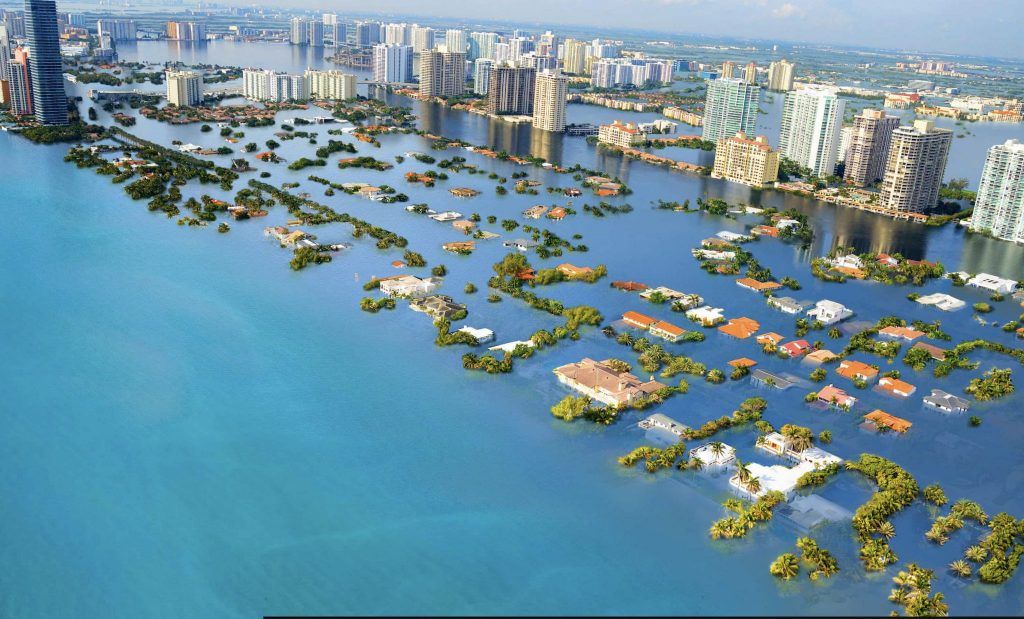Hard numbers help visualize climate change. And it’s not pretty.
By Dan Drollette Jr | February 8, 2019
 What South Beach, Miami, would probably look like if temperatures rise by 2 degrees Celsius.
Image courtesy of Nickolay Lamm/ClimateCentral/sealevel.climatecentral.org
What South Beach, Miami, would probably look like if temperatures rise by 2 degrees Celsius.
Image courtesy of Nickolay Lamm/ClimateCentral/sealevel.climatecentral.org
When it comes to anthropogenic climate change, one of the biggest problems is grasping the problem’s sheer scale—and what its follow-on effects could mean for the everyday life of us fortunate enough to be in developed countries.
After all, it is one thing to say that the Paris agreement could allow global average temperatures to rise by as much as an intolerable 2 degrees Celsius (3.6 degrees Fahrenheit).
But it’s still just a bunch of numbers.
And even knowing that this figure translates to as much as six feet of sea-level rise does not really strike the casual reader in a visceral way.
Recognizing this problem, more and more organizations, such as Climate Central, have developed extensive on-line interactive mapping tools that allow the user to see what six feet (or more) of sea level rise means. Simply go to the “Seeing Choices” section of their site, enter a coastal location—such as Miami, Boston, New York City, or Everglades City—and watch the amount of flooding that occurs for every half-degree of heat rise. Much of Miami essentially sinks, Boston becomes an island, and Manhattan a narrow strip of its old self. And tiny communities such as Florida’s Everglades City (pop. 402) become part of the Gulf of Mexico.
And Climate Central is not the only one with such tools lately; the Union of Concerned Scientists (UCS) has an interactive site that allows users to search “US Coastal Property at Risk from Rising Seas” by state, city, and zip code.
But one of the most telling tools is a simple, old-fashioned chart that appears, of all places, in an article in Miami Agent—a magazine devoted to Miami real estate property. In “How global warming will impact Miami real estate by 2030,” the article notes that Florida stands to lose the most from climate change, with land in South Florida being the target of the waves, and Miami the bulls-eye.
The article also notes that—for once—ultra-luxury housing will be the most endangered; just the 15 houses at risk in Miami’s Coconut Grove district alone represent $36 million in property values that would disappear beneath the waves. The numbers are eye-popping, with figures in the billions for Miami, and over $1 trillion for Miami Beach. (No, that’s not a typo, it really is trillion.)
And the impact of rising sea levels is not relegated just to home and property value loss. The sinking of much of the city and its suburbs represents the loss of a big portion of the area’s tax base, along with likely top-to-bottom changes in how flood insurance programs, the mortgage industry, developers, and virtually everyone and everything remotely tied to the state’s real estate industry function.
As flood policy expert John Miller notes in a 2018 UCS study titled Underwater: Rising Seas, Chronic Floods, and Implications for US Coastal Real Estate: “I believe that we will see credit downgrades sooner than later. Property values will be impacted as chronic flooding increasingly manifests. Reinsurers will be wary ahead of exposure in coastal areas.”
Not to mention the fact that as a state that is already barely above sea level to begin with, Florida has to deal with how to protect (or move) the nation’s three most low-lying nuclear power plants. The state’s St. Lucie reactor is located on a barrier island and “is particularly vulnerable because during the reactor’s lifetime it is projected to encounter a rise in sea levels that exceeds its flood design,” wrote researcher Natalie Kopytko for the Bulletin in 2015.
Publication Name: Miami Agent
To read what we're reading, click here
Together, we make the world safer.
The Bulletin elevates expert voices above the noise. But as an independent nonprofit organization, our operations depend on the support of readers like you. Help us continue to deliver quality journalism that holds leaders accountable. Your support of our work at any level is important. In return, we promise our coverage will be understandable, influential, vigilant, solution-oriented, and fair-minded. Together we can make a difference.
Keywords: cities and climate change, climate change communication
Topics: Analysis, Climate Change, What We’re Reading















At some point, when the water is at the door, people have to catch up with reality.